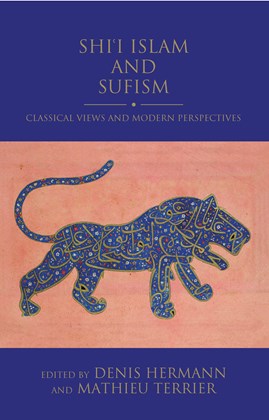Shiʿi Islam and Sufism Classical Views and Modern Perspectives
I.B. Tauris in association with the Institute of Ismaili Studies
Offering new perspectives on the relationship between Shiʿis and Sufis in modern and pre-modern times, this book questions any supposed opposition between these two esoteric traditions in Islam by exploring what could be called Shiʿi Sufism and Sufi-oriented Shiʿism at various points in history. The essays collected here are based on new research, in textual studies as well as fieldwork, from a broad geographical area including the Indian subcontinent and Anatolia in addition to Iran. They cover a long period stretching from the early post-Mongol centuries, throughout the entire Safawid era (906–1134/1501–1722) and beyond, and are concerned not only with the sphere of the religious scholars, but also with different strata of society.
The first part of the volume looks at the diversity of the discourse on Sufism among the Shiʿi ʿulamaʾ, in the run up to and during the Safawid period. The second part focuses on the social and intellectual history of the most popular Shiʿi Sufi order in Iran, the Niʿmat Allāhiyya. The third part examines the relationship between Shiʿism and Sufism in the little-explored literary traditions of the Alevi-Bektashi and the Khāksāriyya Sufi order.
Contributors
Acknowledgements
Transliteration and Dates
Abbreviations
Introduction: New Perspectives on Imami Shiʿi–Sufi Relations in the Modern and Pre-Modern Periods
Denis Hermann and Mathieu Terrier
Part 1: Alternatives to Anti-Sufi Discourse in Pre-Modern and Modern Shiʿi Literature
1. The Defence of Sufism among Twelver Shiʿi Scholars of Early Modern and Modern Times: Topics and Arguments
Mathieu Terrier
2. The Limits of ‘Orthodoxy’? Notes on the Anti-Abū Muslim Polemic of Early 11th/17th-Century Iran
Andrew Newman
Part 2: The Social History of a Shiʿi Sufi Brotherhood: The Niʿmat Allāhiyya
3. Between the Spiritual and Material: The Niʿmat Allāhī Order’s Institutionalisation and Architectural Patronage in the 9th/15th Century
Peyvand Firouzeh
4. The mujaddid and the majdhūb: Shāh ʿAlī Riḍā (d. 1215/1801) and the Different Narratives of the Niʿmat Allāhī Renewal
Fabrizio Speziale
5. The Institutionalisation of Niʿmat Allāhī Sufism during the Pahlavi Era: A Study of the Establishment of the Ḥusayniyya of Amīr Sulaymānī as a waqf in Tehran
Denis Hermann and Omid Rezai
6. Text and Contest: Theories of Secrecy, taqiyya and Archiving Practices in 20th- and 21st-Century Niʿmat Allāhī Sufism
Seema Golestaneh
Part 3: Relations between Shiʿism and Sufism in Other Sufi Literary Traditions
7. Sufism and Shiʿism in South Asia: Shahādat and the Evidence of the Sindhi marthiya
Michel Boivin
8. Red Sulphur, the Great Remedy and the Supreme Name: Faith in the Twelve Imams and Shiʿi Aspects of Alevi-Bektashi Piety
Rıza Yıldırım
9. The Khāksār Shiʿi Sufi Order: An Updated Introduction
Alexandre Papas
10. ʿAjam Sufis and Shiʿi Spirituality in 19th-Century Iran
Lloyd Ridgeon
11. Two Khāksār Treatises of the 19th Century: The Fourteen Families (Chahārdah khānawādah) and The Booklet of Poverty (Risāla-yi faqīriyya)
Yaser Mirdamadi and Mehrdad Arabestani
Index
Denis Hermann was born in Paris in 1977. Currently director of the IFRI (Institut Français de Recherche en Iran), he is a historian who works mainly on Qajar Iran, Twelver Shiʿism and the Constitutional Revolution in Iran of 1906–1911. He has published Le shaykhisme à la période qajare: Histoire sociale et doctrinale d’une École chiite (Turnhout, 2017); Kirmānī Shaykhism and the ijtihād: A Study of Abu al-Qāsim Khān Ibrāhīmī’s Ijtihād wa taqlīd (Würzburg, 2015); ed. with F. Speziale, Muslim Cultures in the Indo-Iranian World during the Early-Modern and Modern Periods (Berlin, 2010); ed. with S. Mervin, Shiʿi Trends and Dynamics in Modern Times (XVIIIth–XXth centuries) (Beirut, 2010).
Mathieu Terrier, born in 1973, is a historian of Islamic thought. Currently a research fellow at the CNRS (Centre national de la recherche scientifique), he is member of PSL Research University, and lecturer in Arabic philosophy in Paris Nanterre University. His research deals mainly with the relationship between Shiʿi Islam, philosophy and Sufism in Iran, before and during the Safavid period. His publications include Histoire de la sagesse et philosophie shiʿite: “L’Aimé des cœurs” de Quṭb al-Dîn Ashkevarî (Paris, 2016).

